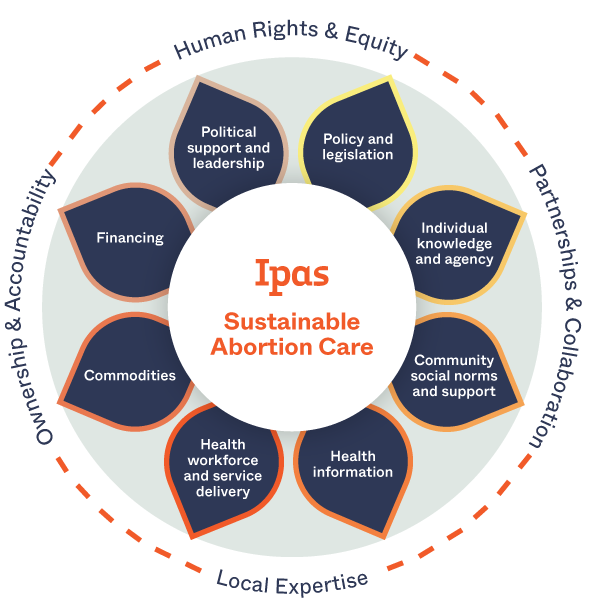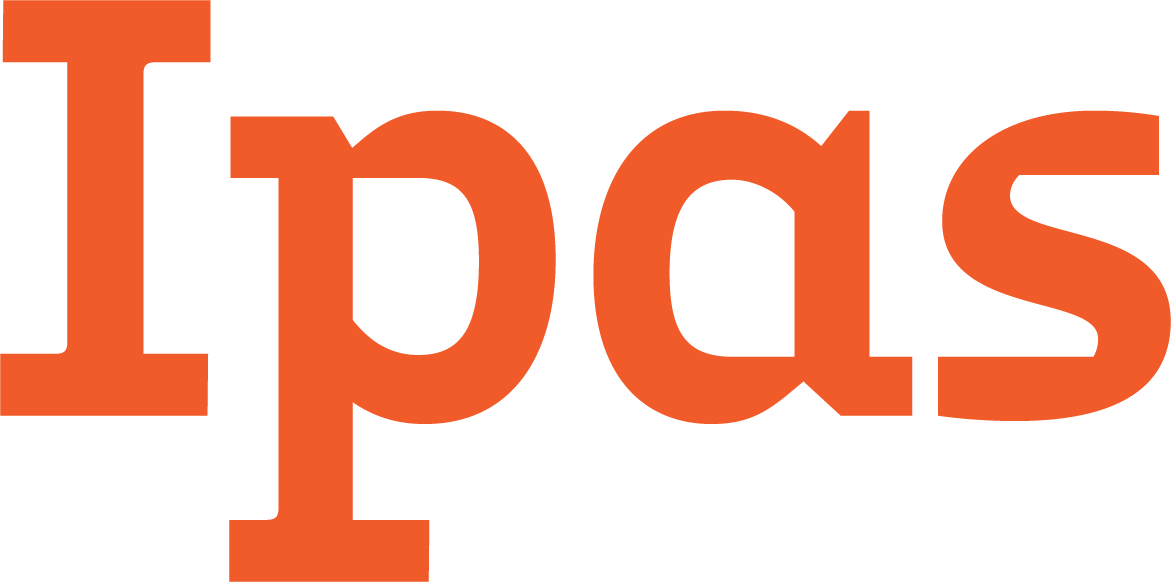At Ipas, we’re working with partners to build sustainable abortion ecosystems, recognizing that there are multiple factors that influence an individual’s ability to access abortion. In a sustainable abortion ecosystem, resilient local stakeholders and systems are actively accountable and committed to abortion rights and responsive to everyone’s abortion needs. In such an ecosystem, people have the information they need to make decisions about abortion and reproduction, there is community and political support for human rights and abortion access, and there are laws and policies that support comprehensive abortion care, sexual and reproductive health, and bodily autonomy.
There are eight components in our framework for a sustainable abortion ecosystem. We’ve also identified four essential drivers of the abortion ecosystem that are integral to achieving sustainability within every component: human rights and equity, partnerships and collaboration, local expertise, and ownership and accountability. Learn more about the eight components and four essential drivers below.

8 components of the abortion ecosystem
Individual knowledge and agency
In a sustainable abortion ecosystem, women and girls have accurate information and understanding to inform their reproductive health decisions, including on abortion, and they can act independently to make their own choices regarding abortion. Knowledge relies on an environment where social norms support free choice and access to accurate sexual and reproductive health information, including comprehensive sexuality education. Progressive social norms, particularly on gender and power dynamics, provide an environment in which women and girls make their own decisions. Social support can also create access to accurate information and contributes to women’s and girls’ agency. When community members have knowledge and agency, they can influence the political process and help shape the political landscape for abortion access.
Community social norms and support
In a sustainable abortion ecosystem, social norms are free of abortion stigma and discrimination and are supportive of people’s ability to exercise their sexual and reproductive health and rights. Community-based and civil society organizations and other community members are informed and empowered to uphold women’s and girls’ human rights and are committed to holding duty-bearers accountable. Social norms and expectations related to abortion may affect if, where and how individuals seek information and health services.
Political support and leadership
In a sustainable abortion ecosystem, government stakeholders demonstrate prioritization of sexual and reproductive health and rights by respecting, protecting, and fulfilling human rights obligations. Prioritization of abortion means a commitment to ensuring meaningful access to comprehensive abortion care for all who need it, informed by available health information. To sustain political support and leadership, there must be effective and reliable champions for abortion access at all levels of government and the health sector (public and private) and a well-functioning and effective civil society movement that is mobilized around advocacy and political accountability for abortion access.
Policy and legislation
Political support and leadership drive the legal and policy framework that is necessary to realize an individual’s abortion rights. Foremost, this includes laws, policies and other regulatory actions that support comprehensive abortion and postabortion care and medical abortion, as well as overall sexual and reproductive health and well-being. Laws and policies on gender equality, public health and protection from violence are also critical aspects of the legal and policy framework for realizing abortion rights.
Financing
Financing for the abortion ecosystem includes mechanisms that ensure resilient, affordable, equitable access to abortion care across the entire health system. Political support and leadership are critical to ensuring that there are commitments to these financing mechanisms. As the ecosystem moves toward sustainability, there will be incremental increases in allocations for abortion care in national plans and budgets in order to meet population health needs. In a sustainable abortion ecosystem, civil society and community groups are engaged in advocacy on financing for abortion access and have resource generation capacity.
Commodities
Abortion commodities refer to the drugs and supplies required for abortion services. The sustainable supply of these commodities requires a supply chain where local systems are committed to having commodities available at the right place, at the right time, in the right quantity and in the right condition. In a sustainable abortion ecosystem, local systems are informed by policy and legislation and financed in a manner that gives them the ability to deliver on that commitment. Commodities are available in an uninterrupted manner over time and people have access to medical abortion drugs on their own. A person’s health decisions are based on need and preference, not on what happens to be in stock.
Health workforce and service delivery
In a sustainable abortion ecosystem, public and private evidence-based abortion services are shaped by individual and community needs. Universal access to services is sustained and supported by policy and legislation, adequate funding and appropriate commodities. Services are free of stigma, respect human rights and are available through a trained and supported health workforce that meets clinical and service delivery standards. Service delivery outcomes inform continuous quality improvement, meet community needs and support and inform political will and action.
Health information
In a sustainable abortion ecosystem, information systems and local capacity are in place to identify, collect, document, and use data on current and emerging reproductive health needs, including abortion. Civil society and community stakeholders participate in identifying data needs, and there is joint ownership of results to ensure data positively influences the ecosystem for abortion care. Health programming utilizes health outcome data to prioritize, develop and implement programs that effectively address abortion care needs.
4 essential drivers of the abortion ecosystem
Human rights and equity
Human rights are universal and indivisible. When abortion-related health rights are firmly rooted in the public health system, abortion care is more likely to be sustained over time. To accomplish this, human rights-based analyses, framing and implementation strategies must be tailored for the local context and applied regularly and consistently across all aspects of programming.
Partnerships and collaboration
To ensure the ecosystem can maintain a solid network of relationships, effective partnerships, and collaboration over the long term, it is crucial to engage early and often with key stakeholders and partners for collaborative strategic planning discussions throughout implementation.
Local expertise
Without local expertise to guide progress, an abortion ecosystem will not survive. All programming must therefore prioritize local ownership, which includes ensuring adequate time and commitment to this driver from the start. Programs should regularly offer technical support, assistance and capacity strengthening where it is needed.
Ownership and accountability
To demonstrate their commitment, government actors must have space to engage at every major stage of work. Successful approaches involving ownership and accountability often mean working with local communities and health professional associations to educate and hold accountable policymakers and health authorities to meet the needs of the individuals being served.
